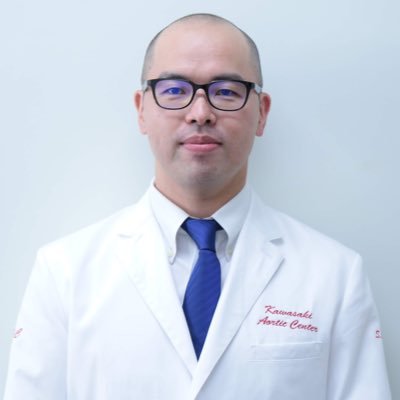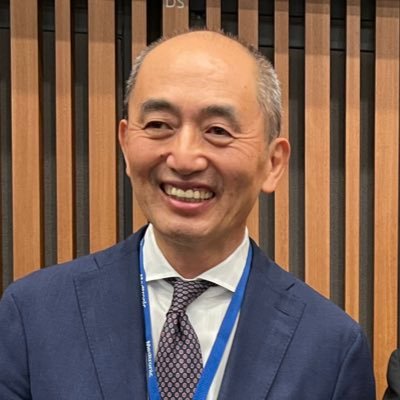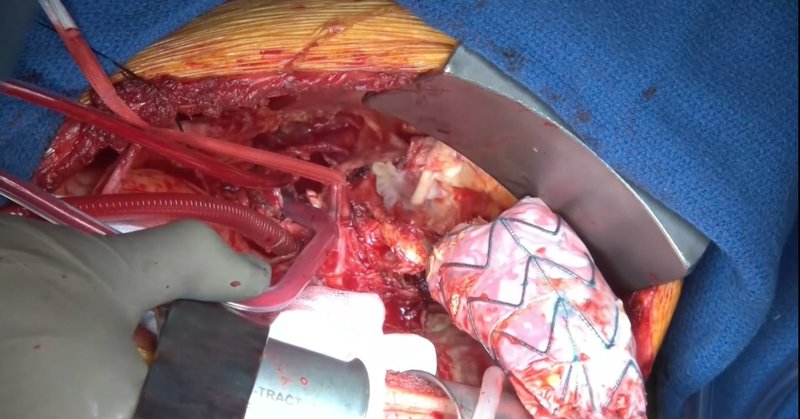
大島 晋 | 大動脈外科 (Susumu Oshima | Aortic surgery)
@SusumuOshima
Followers
2K
Following
2K
Media
239
Statuses
613
川崎幸病院大動脈センターでは年間600件胸部大動脈手術を行っています。I’m an aortic surgeon from Japan. Kawasaki Aortic Center where I am chief, has the largest number of aortic surgery in Japan.
神奈 川崎市 幸区
Joined September 2010
川崎大動脈センターで治療を行なっている主な大動脈疾患 •大動脈解離 •弓部大動脈瘤 •基部大動脈瘤 •胸腹部大動脈瘤 •下行大動脈瘤 •大動脈弁輪拡張症 •上行大動脈瘤 •腹部大動脈瘤 *動脈径が50mmを超えていると言われた方は早めに受診して下さい。 川崎大動脈センター 044-544-4611(代表)
1
7
78
KACに関わった人達が大活躍しており、我々もこのような発表機会を頂きました。ステントグラフトに関しては台湾の先生たちは日本よりアグレッシブに行っており、どうやってリカバリーショットをするのか考える機会も得ました。これからも台湾の大動脈外科医と共に切磋琢磨していきます。
0
0
3
今回のTSVS2025ではre-do Bentall手術における吻合テクニックを紹介しました。色んな画像生成AIで上手に作れるか描いてみましたが、結果的には自分で描いた絵になりました😅
1
0
10
台湾のTSVS2025に参加しました。台湾の先生たちとの交流はもうかれこれ10年になります。日本の先生たちよりも頻繁に会っているのでとても居心地よくリラックスしてるディスカッション出来ました。
1
0
15
サルモネラやカンピロバクターによる感染性動脈瘤も危険です。細菌性腸炎は時に命に関わるので、肉は必ず加熱して食べてください。以下AIが教えてくれました。 カンピロバクター属(特にC.
【危険】BreakingDown選手、スーパーの鶏肉を生食 X投稿途絶える https://t.co/p49OXWl92O 森は、8月29日にXで「スーパーの鶏肉を鳥刺しにして食べた」と投稿。3日現在、投稿が途絶えている。森は2月にも消費期限切れの「加熱調理用」の牡蠣を生食し、胃腸炎になっていた。
0
4
13
【危険】BreakingDown選手、スーパーの鶏肉を生食 X投稿途絶える https://t.co/p49OXWl92O 森は、8月29日にXで「スーパーの鶏肉を鳥刺しにして食べた」と投稿。3日現在、投稿が途絶えている。森は2月にも消費期限切れの「加熱調理用」の牡蠣を生食し、胃腸炎になっていた。
939
5K
56K
Today’s discussion in KAS focused on hemostatic management in aortic surgery with bleeding tendencies, highlighting three main aspects: 1. Evaluation of Coagulopathy and Use of TEG Conventional coagulation tests (PT, APTT, INR) reflect only parts of the coagulation cascade. In
0
0
11
シンガポールのNational University Heart CenterでVitaly教授主催のcadaver workshopに参加しました。
1
0
22
VITALY先生に招待してもらいシンガポールに来ました。明日は朝7時半からNATIONAL UNIVERSITY HEART CENTRE, SINGAPORE (NUHCS)で大動脈基部手術について発表してきます。
0
0
18
今日のKawasaki Aortic Surgeryオンラインカンファレンス。今日は当センターで使用し始めたfrozen elephant trunkについてサイジングや適応について話し合いました。国によって使われている人工血管も違ったりして面白いディスカッションが出来ました。 Today's Kawasaki Aortic Surgery online
0
0
25
Youngest AAA we have operated. 6 months old baby with 3.7cm AAA. Genetic workup- FBN1 mutation. Repaired with Dacron graft 3 yrs ago. Doing fine now. #aortaed @sctimst_tvm @PrajnaKota
8
8
67
In the afternoon, I visited Wuhan to observe Prof. Wei’s trans-apical beating myectomy. Despite it being Sunday, he kindly showed me two cases. Since 2021, nearly 900 cases have already been performed—remarkably smart and effective, potentially rivaling Mavacamten.
0
2
26
大動脈解離に基づく動脈瘤は、時間が経つにつれ偽腔側の血管壁が石灰化し、血栓も多くなります。 そうなると吻合は難しく、塞栓症のリスクも増します。 大きくなる前に適切な時期で手術を行うことが重要です。定期的なフォローアップを忘れずに。 Aortic aneurysms with underlying dissection often
0
3
37
大動脈吻合部出血の原因🩸 1️⃣ドッグイヤー 💊単結節追加 2️⃣石灰化 💊石灰化内膜剥離 3️⃣糸の緩み 💊締め上げ、フェルトプレジェット吻合 4️⃣大動脈壁の針穴 💊垂直な刺入、単結節追加 ⛔️止血剤は最終手段
1
3
36
📁若い頃から大動脈瘤のある方。当センターへの紹介状を去年もらっていたものの、本人曰く、ブラック企業に勤めたために休みが取れず、外来診療に来ることが出来なかったとのこと。結局破裂してから緊急手術。 🩺緊急手術のリスクは予定手術の10倍。 🩻大動脈瘤や解離のフォローはとても大切。
0
3
28
FBN1遺伝子異常により発症する結合織疾患であるマルファン症候群。大動脈基部の拡張や水晶体偏位、側彎症、高身長、長い手指などが特徴だが、一番命の危険となるのが大動脈基部拡大。大動脈基部が拡大すると大動脈解離を引き起こし、結合織疾患の方では多くの場合、全身の大動脈に波及する。こうなると
0
15
91
今日はこれからJohnson &Johnson主催のウェビナーで胸骨創傷治癒について発表させて頂きます。
0
0
20
Our center receives many complex cases, like the intricate ones depicted in this drawing. Both required incredibly challenging surgeries, especially those involving connective tissue diseases, aortic dissection, and stent graft placement in younger patients. These procedures
0
7
62





